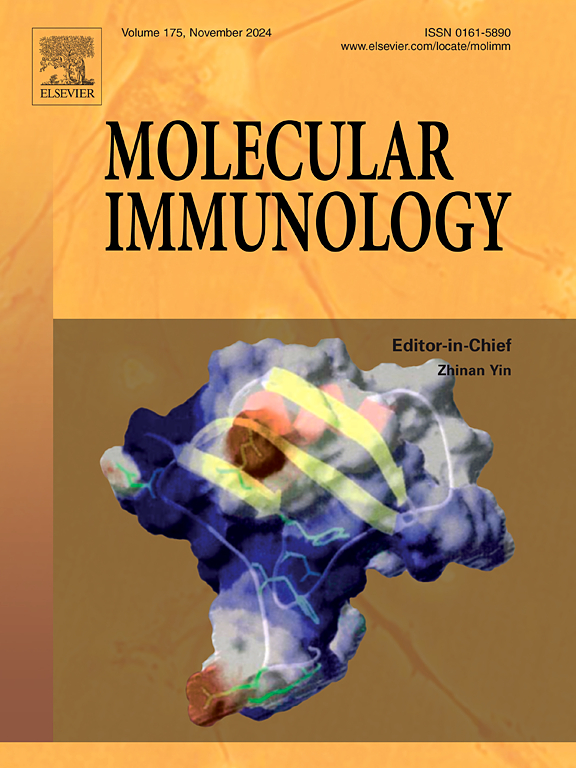Trogocytosis-mediated acquisition of MHC class II molecules from plasmacytoid dendritic cells confers donor-specific immune tolerance to CD8+CD45RClow/- regulatory T cells
IF 3
3区 医学
Q2 BIOCHEMISTRY & MOLECULAR BIOLOGY
引用次数: 0
Abstract
Objective
Donor-specific suppression by MHC-II+CD8+CD45RClow/-regulatory T cells (Tregs) was observed in our prior study, here we endeavor to investigate the mechanism underlying generation of the MHC-II+CD8+CD45RClow/-Tregs.
Methods
The presence of MHC-II+CD8+CD45RClow/-Tregs within tolerated grafts was confirmed using a multicolor immunofluorescence technique in spontaneous tolerant rat liver transplant model. We aimed to elucidate the generation mechanism of MHC-II+CD8+CD45RClow/-Tregs by purifying naive CD8+CD45RClow/-Tregs and plasmacytoid dendritic cells (pDCs) from recipients and co-culturing them to induce trogocytosis. Initially, we examined the immunophenotype and cytokine secretion of MHC-II+CD8+CD45RClow/-Treg using flow cytometry. Trogocytosis of peptide-MHC class II complexes was visualized using a confocal microscope. Subsequently, we analyzed the donor-specific inhibitory effect of MHC-II+CD8+CD45RClow/-Tregs using CFSE-based lymphocyte proliferation analysis. Finally, we explored the possible transfer mechanisms of MHC class II using IFN-γ stimulation and 1-MT to block indoleamine-(2,3)-dioxygenase (IDO).
Results
In the spontaneously tolerant rat liver transplants, MHC-II+CD8+CD45RClow/-Tregs and IL-10 expression were upregulated. Our in vitro study revealed that trogocytosis occurring between naive CD8+CD45RClow/-Tregs and pDCs could induce MHC-II+CD8+CD45RClow/-Tregs. The semi-direct pathway represents the primary mode of Trogocytosis-mediated transfer of MHC-II molecules from pDCs to CD8+CD45RClow/-Tregs. The MHC-II+CD8+CD45RClow/-Tregs exhibited high secretion of IL-10 and IFN-γ. Co-culturing with MHC-II+CD8+CD45RClow/-Tregs significantly suppressed the proliferation of CD4+CD25-effector T cells. Moreover, this inhibitory effect was donor-specific and could be overcome in the presence of third-party antigen-presenting cells. Our data also suggested that blocking the IFN-γ/IDO signaling pathway could inhibit the generation of trogocytosis-mediated MHC-II+CD8+CD45RClow/-Tregs.
Conclusions
MHC-II+CD8+CD45RClow/-Tregs generated through trogocytosis exhibit donor-specific suppressive function. Moreover, in vitro generation of MHC-II+CD8+CD45RClow/-Tregs offers a potential alternative approach to induce donor-specific immune tolerance through adoptive transfer.
巨噬细胞介导的从浆细胞样树突状细胞获得MHC II类分子赋予供体特异性免疫耐受CD8+ cd45rlow /-调节性T细胞
目的在我们之前的研究中观察到MHC-II+CD8+CD45RClow/-调节性T细胞(Tregs)对供体特异性的抑制,在这里我们试图探讨MHC-II+CD8+CD45RClow/-Tregs产生的机制。方法采用多色免疫荧光技术,在自发性耐受大鼠肝移植模型中证实MHC-II+CD8+ cd45rlow /-Tregs在耐受移植物中的存在。我们的目的是阐明MHC-II+CD8+CD45RClow/- treg的产生机制,通过纯化来自受体的初始CD8+CD45RClow/- treg和浆细胞样树突状细胞(pDCs),并共同培养它们来诱导巨噬细胞增生。首先,我们使用流式细胞术检测MHC-II+CD8+ cd45rlow /-Treg的免疫表型和细胞因子分泌。用共聚焦显微镜观察肽- mhc II类复合物的巨噬细胞作用。随后,我们使用基于cfse的淋巴细胞增殖分析分析了MHC-II+CD8+CD45RClow/-Tregs的供体特异性抑制作用。最后,我们探索了使用IFN-γ刺激和1-MT阻断吲哚胺-(2,3)-双加氧酶(IDO)的MHC II类可能的转移机制。结果自发耐受大鼠肝移植后,MHC-II+CD8+ cd45rcross /-Tregs和IL-10表达上调。我们的体外研究表明,在初始CD8+CD45RClow/- treg和pDCs之间发生的细胞形成可以诱导MHC-II+CD8+CD45RClow/- treg。半直接途径代表了巨噬细胞介导的MHC-II分子从pDCs转移到CD8+CD45RClow/-Tregs的主要模式。MHC-II+CD8+CD45RClow/-Tregs表现出高IL-10和IFN-γ的分泌。与MHC-II+CD8+CD45RClow/-Tregs共培养可显著抑制CD4+ cd25效应T细胞的增殖。此外,这种抑制作用是供体特异性的,可以在第三方抗原呈递细胞存在的情况下被克服。我们的数据还表明,阻断IFN-γ/IDO信号通路可以抑制巨噬细胞病介导的MHC-II+CD8+CD45RClow/-Tregs的产生。结论smhc - ii +CD8+ cd45rcco /-Tregs通过细胞吞噬产生具有供体特异性抑制功能。此外,体外生成MHC-II+CD8+ cd45rchloe /-Tregs提供了一种通过过继转移诱导供体特异性免疫耐受的潜在替代方法。
本文章由计算机程序翻译,如有差异,请以英文原文为准。
求助全文
约1分钟内获得全文
求助全文
来源期刊

Molecular immunology
医学-免疫学
CiteScore
6.90
自引率
2.80%
发文量
324
审稿时长
50 days
期刊介绍:
Molecular Immunology publishes original articles, reviews and commentaries on all areas of immunology, with a particular focus on description of cellular, biochemical or genetic mechanisms underlying immunological phenomena. Studies on all model organisms, from invertebrates to humans, are suitable. Examples include, but are not restricted to:
Infection, autoimmunity, transplantation, immunodeficiencies, inflammation and tumor immunology
Mechanisms of induction, regulation and termination of innate and adaptive immunity
Intercellular communication, cooperation and regulation
Intracellular mechanisms of immunity (endocytosis, protein trafficking, pathogen recognition, antigen presentation, etc)
Mechanisms of action of the cells and molecules of the immune system
Structural analysis
Development of the immune system
Comparative immunology and evolution of the immune system
"Omics" studies and bioinformatics
Vaccines, biotechnology and therapeutic manipulation of the immune system (therapeutic antibodies, cytokines, cellular therapies, etc)
Technical developments.
 求助内容:
求助内容: 应助结果提醒方式:
应助结果提醒方式:


